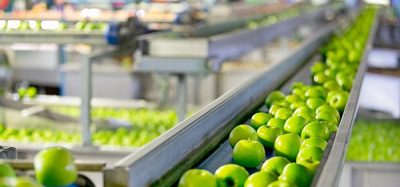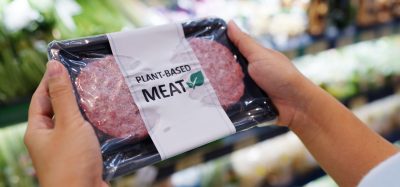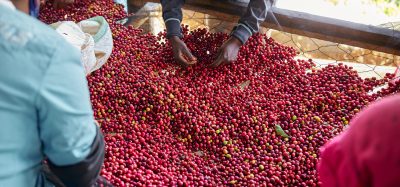Can blockchain provide a safer, more transparent supply chain?
- Like
- Digg
- Del
- Tumblr
- VKontakte
- Buffer
- Love This
- Odnoklassniki
- Meneame
- Blogger
- Amazon
- Yahoo Mail
- Gmail
- AOL
- Newsvine
- HackerNews
- Evernote
- MySpace
- Mail.ru
- Viadeo
- Line
- Comments
- Yummly
- SMS
- Viber
- Telegram
- Subscribe
- Skype
- Facebook Messenger
- Kakao
- LiveJournal
- Yammer
- Edgar
- Fintel
- Mix
- Instapaper
- Copy Link
Posted: 18 November 2019 | Bethan Grylls (New Food) | 2 comments
Leaders from the food and beverage industry will come together in New Food’s two-day event next year to discuss how we, as an industry, can improve the integrity of our systems. Experts will debate a range of key topics; among the skilled speakers is Julie Pierce of the FSA, who will be speaking about the organisations’ blockchain pilots and the benefits this technology can offer to the sector.


Food Integrity 2020 will see leaders from the food and beverage sector coming together to debate the challenges facing the industry and share their lessons and solutions. Here, Bethan Grylls, New Food’s Editor, takes a moment to look at how this technology has been used so far, and speak to Julie Pierce, Director of Openness, Data & Digital; and Wales at the FSA, who will be discussing at the event, among other matters, how technology can help create a safer, more transparent global supply chain.
What is ‘blockchain’?
One in 10 people across the world fall ill after eating contaminated food every year, and 420,000 of them die.1 Some experts argue that blockchain has the potential to improve the integrity of the global supply chain, reducing the number of food fraud incidents and increasing safety for all.


“A blockchain is a distributed database that collates records and puts them in one block – similar to putting records on a paper,” Pierce told New Food. “Each block is then ‘chained’ to the next block with an encrypted signature. The process allows the blockchains to be used like a ledger so they can be shared and checked by anyone with the appropriate permission to do so.
“Using blockchain in the food chain has the potential to improve traceability of the supply chain, enabling users to view the relevant data digitally, remove duplication in reporting and paperwork, and use smart contracts to ensure the process is automated where feasible. And then, all of this drives speed of moving data through the system, so recalls could be managed in minutes rather than weeks, and suppliers can be paid immediately.”
Blockchain and the supply chain
In 2018, there was a large outbreak of E. coli in romaine lettuce and Salmonella in a number of products. Consequently, a lot of customers and grocers had to throw away huge amounts of romaine lettuce, with health officials warning to avoid eating leafy greens grown in Yuma, Arizona. The problem was that it was tricky for people to identify whether the lettuce was indeed from Yuma, as they were reportedly not labelled with such information.
In response, Walmart requested that its suppliers of leafy greens “trace their products all the way back to the farm using blockchain technology”. This would potentially allow customers to scan a bag of salad in the future and know where it came from. The company added that digitising the system could also speed up the identification, research and reaction time to food safety situations.
Similarly, Raw Seafoods, Inc., has suggested the technology could be used to improve the safety of seafood.
“We first began investigating the potential for blockchain to improve our own processes after observing its role in helping brands respond to E. coli outbreaks that stemmed from leafy greens,” Dan McQuade, VP of Marketing, Raw Seafoods, wrote in a IBM blog published last month. “While farmed romaine lettuce and sea-caught scallops have little in common, we soon realised that by digitising the food supply chain and creating an immutable record of each catch, we could solve a trifecta of the seafood industry’s most pressing problems.” Namely, fraud and transparency.
The Food Standards Agency
The Food Standards Agency (FSA) successfully completed two pilots using blockchain technology back in 2018.
The first was implemented for the FSA and two food businesses across three plants. The blockchain shared data known as ‘Collection and Communication of Inspection Results’ (CCIR). This is data which the FSA has a legal obligation to collect and share with the food producer; it allows them to take any action required at a farm to improve food safety as well as to protect animal health and welfare.


Julie Pierce
“We have also completed a second pilot on Pork Export Health Certification with a large food business,” Pierce said. “Both pilots have demonstrated the opportunities for stakeholders across the supply chain to use data to improve traceability, minimise avoidable work and identify ways to improve existing process, all of which would allow Official Veterinarians more time to focus on other issues,” she explained. “We have been able to test data quality, data standards and take up across the industry. The pilots have also highlighted the importance of having a governance approach which is centred around trust and standards.
“The tech development is currently paused to enable us to work with industry and other government departments to identify principles and options for how this data is managed. This includes looking at different models for ensuring data trust. The initial phase of this work is likely to conclude in March 2020 and the findings will inform the next stage of development.”
She added, “One of the biggest challenges, but also opportunities, facing us is the wide range of data we have to pull together, with slightly different definitions, different standards and originally created for different purposes. Consistency of the collection of the data would mean it could be linked together and greater insight and value derived. Can we see trends across the country in a particular business? Are there correlations between business’ financial and food safety performance?”
Trusting blockchain
However, some have expressed worries over whether to trust blockchain. New Food asked Pierce whether there was any foundation to these fears:
“For many, blockchain is synonymous to cryptocurrencies, such as Bitcoin, so its application in other sectors is viewed with a degree of scepticism. It is also a relatively new and emerging technology without widely accepted standards.
“The very nature of blockchain’s decentralised nature, which is meant to enhance trust, could make participants nervous as there is not a single centralised authority. To build trust, any blockchain deployment needs to pay careful attention to a multitude of factors including what data is included ‘on chain’ vs. ‘off chain’, access rights, design of the underlying system and the quality of the data.”
She continued, “Like most technologies, blockchain can be an enabler. Trust in blockchains should be considered on a case-by-case basis. Some of the factors to consider include data quality, use of and access to data and design of the blockchain rather than a general trust of blockchain per se. The decision should go back to first principles as how you would take any decision on any new system development.
“There are some features of blockchains that could potentially enhance trust by surfacing data uniformly across various actors, making it harder to manipulate; this is using the shared view of the group to police the blockchain. As transactions and entries at each stage are clearly validated through transparent rules and consensus among multiple parties, trust can be built into each step of the process by removing the risks around a single actor dominating. This ideal of the group working together is particularly appealing in supply chains which are characterised by multiple actors (eg, food businesses, government, logistics) at various stages.”
The future of blockchain
It is difficult to say with any degree of certainty what the future holds, Pierce told New Food, pointing to the growing number of blockchain-focused initiatives emerging within the sector around the world. She added that the lessons that come from these are “invaluable” and demonstrate the importance of adopting standards which focus on data quality and governance. It also highlights wider questions around governance models, the meaning and the value of trust, she noted. “Collaboration across industry players will enable tackling some of these more difficult challenges.”
She questioned how blockchains should exist together and with legacy systems, and what an ecosystem of blockchains looks like. “The potential for blockchain in the food and beverage industry is large,” she said, “but there are many things to be resolved for it to truly deliver on that promise. Many of those decisions may be made elsewhere, for example in other industries like fintech, or by the technology companies themselves. The food and beverage industry might wish to consider whether it wants to play an active role in defining the future of blockchain, or maybe leave others to address the technology and it to address topics only it owns, such as the food business data standards.”
She concluded: “Whilst blockchain is new technology, we see that the real value accrues because of the consistency of the data across different organisations, imposed by the data standards.”
Julie Pierce will part of the panel session: Assessing Supply Chains for Potential Vulnerability to Food Fraud Activities held on day one of the conference (18 March 2020). The panel will be moderated by Professor Louise Manning, and Julie will be joined in discussion by Konstantina Karagkika from Innocent Drinks.
Key topics:
- Understanding the increasing risks associated with constantly evolving supply chains
- New challenges from global economics
- Managing your suppliers’ suppliers and establishing provenance
- Blockchain and new technologies for supply chain visibility and integrity
Food Integrity will be taking place on 18-19 March, 2020 – click here to register today. The full agenda can be viewed here.
References
- https://www-01.ibm.com/events/wwe/grp/grp308.nsf/vLookupPDFs/6%20Using%20Blockchain%20for%20Food%20Safe%202/$file/6%20Using%20Blockchain%20for%20Food%20Safe%202.pdf
Related topics
Beverages, Contaminants, Data & Automation, Food Fraud, Food Safety, Research & development, Supply chain, Technology & Innovation, Traceability
Related organisations
Food Standards Agency (FSA), FSA, IBM, Raw Seafoods Inc, Walmart









Dear Bethan Grylls, your recent article on ‘Can blockchain provide a safer, more transparent supply chain?’ included the claim that “One in 10 people across the world fall ill after eating contaminated food every year, and 420,000 of them die.” But footnote 1 failed to link to a soruce. Please can you indicate the source for that claim?
Hi Erik the link should work, it’s on page 2 of the document. Try this one https://www-01.ibm.com/events/wwe/grp/grp308.nsf/vLookupPDFs/6%20Using%20Blockchain%20for%20Food%20Safe%202/$file/6%20Using%20Blockchain%20for%20Food%20Safe%202.pdf